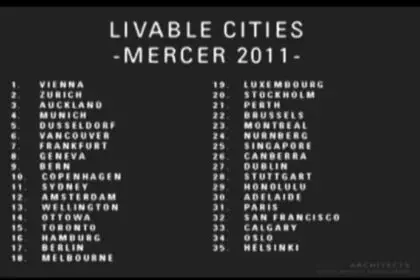Two things stand out about the above list. The first is that not one British City gets mentioned (I don’t think we even scrape into the top fifty.) Second is how many of them have been influenced by a Danish architect called Jan Gehl.
Jan Gehl – Cities for People from Architecture + Design Scotland on Vimeo.
Gehl isn’t your standard superstar architect (apparently they are called “starchitects”) who goes around erecting freestanding, gigantic “perfume bottles”. In fact he’s gloriously rude about his highflying professional colleagues. He refers to them as “bird shit architects” who take a birds eye view of a city “travelling all over the world to drop their towers”. Gehl is more interested in what happens where the building meets the ground, where life is lived – in fact his first book was called Life Between Buildings, Using Public Space, which had a simple message: Take good care of the people and the precious life between the buildings.
Gehl credits the “grandmother” of humanistic planning, Jane Jacobs for drawing attention to the importance of human scale in cities that are good to live in. “Fifty years ago she said – go out there and see what works and what doesn’t work, and learn from reality. Look out of your windows, spend time in the streets and squares and see how people actually use spaces, learn from that, and use it.”
Gehl takes this approach literally, and spends countless hours walking the streets of cities around the world, studying life beneath, between and around buildings. “Man was made to walk”, he reminds us. “All our senses are made for being a walking animal – for that speed, for that horizontal perception – and when we are in that natural environment that we are meant for, then we can watch and talk and kiss as we were meant to as human beings”. Forty years of this close observation of human behavior (he’s confessed many times that he’s not much into theory, though I think it’s a self-deprecating pose) lies behind Gehl’s core beliefs of treating pedestrians and cyclists “sweetly” and the need for the city to be an “invitation” to spend time, a welcoming, attractive and sustaining place for people to live. “A good city is like a good party”, he says. “You know it’s working when people stay for much longer than really necessary, because they are enjoying themselves.”
Gehl is based in Copenhagen – look, it’s on the list, and regularly gets voted World’s Best City – and was responsible for pedestrianising the city centre’s StrØget Street, turning it from a traffic clogged nightmare and business failure into somewhere people wanted to visit, socialise and spend money. Gehl did more than just fiddle around with parking meters and Sunday charging. Leeds take note.
At a rough guess he’s influenced about a third of the cities on that Mercer list, ‘Copenhagenizing’ the world, one city at a time, as he calls it, driven by a fundamental concern for life, rather than the efficient flow of traffic. “In what I call the ‘reconquered cities’, we have won back the right to be in the city from the car, and we can now enjoy the age old joy of people meeting people, which is why people came to cities in the first place”. He’s “Copenhagenized” Melbourne – also on the list, and again regularly voted best city – transforming it from a city where they once rushed to the office and back home again (“like ants to their various places and when they are finished they go down like ants down in the hole again”) to “a city which really is very inviting for promenading, and for lingering and sitting and enjoying, eating and drinking or whatever you do.”
Gehl stresses that you can’t maintain a livable city by throwing up “iconic” buildings, or by privileging the happiness of the car over the interests of people. Rather, it’s how the buildings sit, how they are connected, and how the public spaces around them are organised that will define the success of the cities of the future.
There’s a film about Jan Gehl at this years Leeds International Film Festival, The Human Scale, by Andreas Dalgaard. I don’t think there could be a better time for people in Leeds to to learn about what “best” cities are doing (they aren’t leaving it to inward investment agencies). So, we’ve made a deal with the good people at the film festival – just phone or turn up at the box office and speak the magic words “CV CITY” and you’ll get two for one on your tickets.
Sadly we can’t do much about the parking. Come, watch the film, we can talk about that after.

Copenhagen is an excellent precedent for Leeds to learn from and commit to becoming a truly cycle/pedestrian friendly city. There is a long way to go but we have made a start – visit http://www.leeds-sdg to see what LSDG have already started with the New Leeds South Bank Vision which includes the delivery of the first part (The Hunslet Stray) of a network of green, cycle/pedestrian friendly routes in partnership with Sustrans.
If you feel you can contribute to making the vision a reality e-mail: [email protected] or add a comment to: http://www.leeds-sdg.com